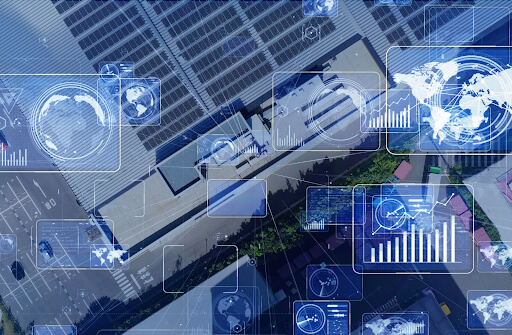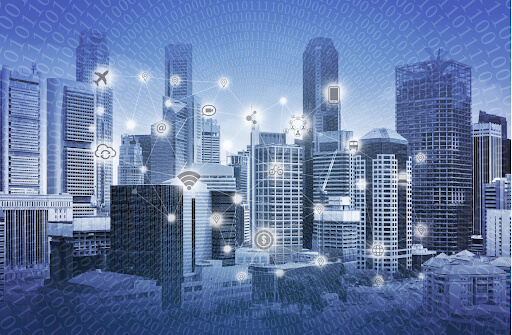 1-800-805-5783
1-800-805-5783 
Monitoring technological developments and understanding how they may affect production always requires more work. Failure to keep up with the latest advancements could have disastrous consequences for your company’s standing in the market. However, staying abreast of the most recent technological innovations is a formidable challenge.
Nowadays, most factories are familiar with cloud computing, AI, and ML. But where do IoT and IIoT fit in? In many cases of digital transformation, a connection is essential, but you might not be aware of its importance. The following article pits IoT vs. IIoT and explains their differences.
What is the Industrial Internet of Things (IIoT)?
It’s a network of self-aware computer devices that create larger systems for industrial-scale data collection, monitoring, and analysis. The IIoT is primarily concerned with applications in the industrial sector, including but not limited to the production of goods, electricity generation, agriculture, and the extraction and processing of oil and gas.
Is IIoT a subset of IoT?
To put IIoT vs. IoT differently, IIoT is a subset of IoT specializing in industrial purposes. The Internet of Intelligent Things (IIoT) relies heavily on intelligent devices, facilitating greater information sharing and real-time data analysis and capture. Improved speed and precision in making business decisions are only two of the ways IIoT helps businesses expand, as they enhance their understanding of and ability to optimize their core business operations.
Through IIoT and IoT platforms, you can monitor your company’s health by collecting and analyzing data in real time. This establishes a network architecture conducive to an organizational setting with an eye toward the future.
What is the Internet of Things (IoT)?

The Internet of Things (IoT) is a network of interconnected, autonomous electronic devices that may gather and share data without human intervention through built-in IOT sensors, electronics, software, connectivity to the Internet, and identifiers and networks. It’s a wireless technology that’s becoming increasingly popular.
The primary purpose of the Internet of Things (IoT) is to empower previously “dumb” devices with computational power, allowing them to connect and share information via the Internet in real-time without the need for human intervention. Everyday items like thermostats, irrigation systems, kitchen appliances, and televisions can all be linked to the Internet via IoT wireless technology.
Differences Between IIoT and IoT
When comparing IoT vs. IIoT, particular key distinctions must be made. For example, consider the following:
A subsection of Particular Interest
The oil and gas, electric utility, and manufacturing sectors are the primary targets of the Industrial Internet of Things. In contrast, IoT is designed for individual use in private settings like homes and offices.
Scale of Application
Millions of individuals might use the output of an IIoT system. However, the Internet of Things is best used for localized, in-home automation that caters to the needs of a limited group of individuals.
Sensor Usage
The IIoT utilizes sensors of all kinds, from pressure and MEMS sensors to velocity, RFID, and torque measuring devices. Alternatively, the Internet of Things relies on relatively simple IoT sensors to monitor temperature, motion, and water levels.
Programming and Networking
Large-scale networking systems are required for IIoT to allow a production manager to monitor factories from a central location. The IIoT apps can be programmed remotely and in real time. Businesses also require an in-house IIoT programmer for maintenance purposes.
In contrast, most smart home devices can be easily programmed by downloading an app on your smartphone.

Security Protocols
Secure Sockets Layer (SSL) encryption, in-transit data authentication, at-rest data encryption, continuous server monitoring, closed-loop systems, and thumbprint login are all essential components of a secure IIoT architecture.
Comparatively, less stringent network IoT security measures are needed to safeguard users’ private information. To now, data privacy has proven to be the most pressing concern regarding IoT security.
Cost
The Internet of Things and the Industrial Internet of Things rely on physical components like sensors, network infrastructure, and embedded systems. However, IIoT devices require a higher level of precision than IoT devices, making IIoT systems more expensive.
Because IIoT works in mission-critical business domains like manufacturing, machinery monitoring, etc., it requires higher-end devices with more precision.
Complexity
IIoT applications are far superior to IoT ones. As technology develops, it becomes more difficult to implement IIoT applications.
Rugged Usage
Instruments, sensors, and gadgets used in the industrial Internet of Things (IIoT) must work in high-velocity, high-temperature, and high-grease conditions. Manufacturers put in extra effort to ensure that their products withstand abuse. In addition, the cloud and the networks themselves require routine upkeep.
In contrast, smart home devices are not designed for heavy use and have a shorter lifespan than their industrial counterparts.
Requirements
The ultimate goal for the Internet of Things is maximizing consumer comfort, while the ultimate goal for the Industrial Internet of Things is maximizing return on investment. The Internet of Things (IoT) is centered on managing home equipment that improves user experience by reducing utility costs (like power use).
In addition to connecting equipment and people, IIoT employs data analytics to improve crucial systems like healthcare, aerospace, and factory automation. IIoT aims to increase the availability of company operations and decrease downtime.
Final Words
The number of Internet-enabled gadgets in people’s homes, workplaces, and industries is expected to grow during the next few years. Learn the critical distinctions between consumer and industrial IoT devices.
In our comparison of IIoT vs. IoT, you can see how the Internet of Things technology may be used in two very different settings: industrial and consumer. IoT applications are different from IIoT. Some examples of the internet of things include IoT in healthcare, banking IoT, and much more. If you are just getting started in the Internet of Things (IoT) industry, you can use these resources to help you get up to speed.
Tags: IIoT, IoT, IoT vs IIoT